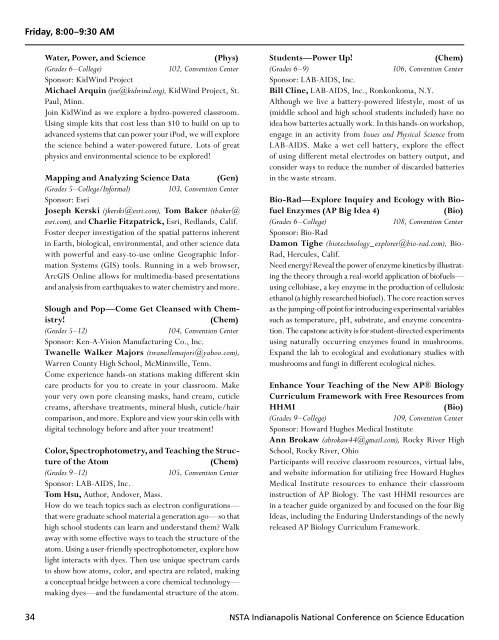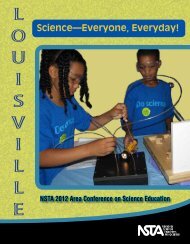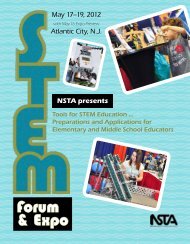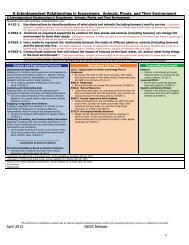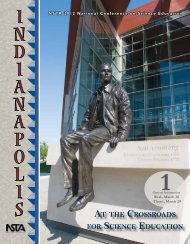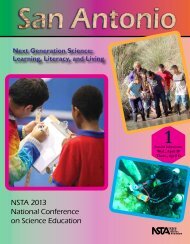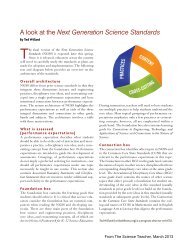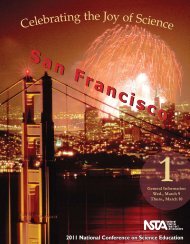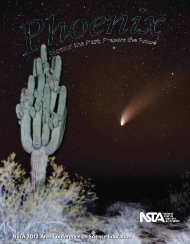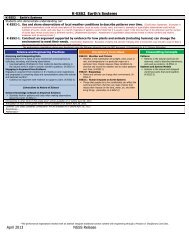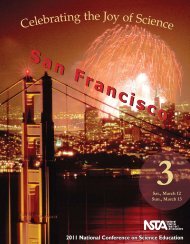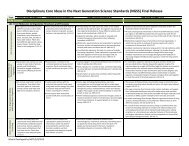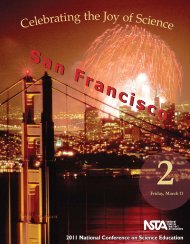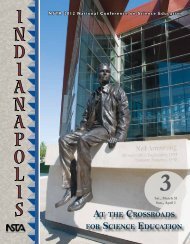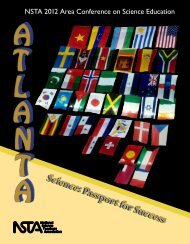I n d i a n a p o l i s
I n d i a n a p o l i s
I n d i a n a p o l i s
You also want an ePaper? Increase the reach of your titles
YUMPU automatically turns print PDFs into web optimized ePapers that Google loves.
Friday, 8:00–9:30 AM<br />
Water, Power, and Science (Phys)<br />
(Grades 6–College) 102, Convention Center<br />
Sponsor: KidWind Project<br />
Michael Arquin (joe@kidwind.org), KidWind Project, St.<br />
Paul, Minn.<br />
Join KidWind as we explore a hydro-powered classroom.<br />
Using simple kits that cost less than $10 to build on up to<br />
advanced systems that can power your iPod, we will explore<br />
the science behind a water-powered future. Lots of great<br />
physics and environmental science to be explored!<br />
Mapping and Analyzing Science Data (Gen)<br />
(Grades 5–College/Informal) 103, Convention Center<br />
Sponsor: Esri<br />
Joseph Kerski (jkerski@esri.com), Tom Baker (tbaker@<br />
esri.com), and Charlie Fitzpatrick, Esri, Redlands, Calif.<br />
Foster deeper investigation of the spatial patterns inherent<br />
in Earth, biological, environmental, and other science data<br />
with powerful and easy-to-use online Geographic Information<br />
Systems (GIS) tools. Running in a web browser,<br />
ArcGIS Online allows for multimedia-based presentations<br />
and analysis from earthquakes to water chemistry and more.<br />
Slough and Pop—Come Get Cleansed with Chemistry!<br />
(Chem)<br />
(Grades 5–12) 104, Convention Center<br />
Sponsor: Ken-A-Vision Manufacturing Co., Inc.<br />
Twanelle Walker Majors (twanellemajors@yahoo.com),<br />
Warren County High School, McMinnville, Tenn.<br />
Come experience hands-on stations making different skin<br />
care products for you to create in your classroom. Make<br />
your very own pore cleansing masks, hand cream, cuticle<br />
creams, aftershave treatments, mineral blush, cuticle/hair<br />
comparison, and more. Explore and view your skin cells with<br />
digital technology before and after your treatment!<br />
Color, Spectrophotometry, and Teaching the Structure<br />
of the Atom (Chem)<br />
(Grades 9–12) 105, Convention Center<br />
Sponsor: LAB-AIDS, Inc.<br />
Tom Hsu, Author, Andover, Mass.<br />
How do we teach topics such as electron configurations—<br />
that were graduate school material a generation ago—so that<br />
high school students can learn and understand them? Walk<br />
away with some effective ways to teach the structure of the<br />
atom. Using a user-friendly spectrophotometer, explore how<br />
light interacts with dyes. Then use unique spectrum cards<br />
to show how atoms, color, and spectra are related, making<br />
a conceptual bridge between a core chemical technology—<br />
making dyes—and the fundamental structure of the atom.<br />
Students—Power Up! (Chem)<br />
(Grades 6–9) 106, Convention Center<br />
Sponsor: LAB-AIDS, Inc.<br />
Bill Cline, LAB-AIDS, Inc., Ronkonkoma, N.Y.<br />
Although we live a battery-powered lifestyle, most of us<br />
(middle school and high school students included) have no<br />
idea how batteries actually work. In this hands-on workshop,<br />
engage in an activity from Issues and Physical Science from<br />
LAB-AIDS. Make a wet cell battery, explore the effect<br />
of using different metal electrodes on battery output, and<br />
consider ways to reduce the number of discarded batteries<br />
in the waste stream.<br />
Bio-Rad—Explore Inquiry and Ecology with Biofuel<br />
Enzymes (AP Big Idea 4) (Bio)<br />
(Grades 6–College) 108, Convention Center<br />
Sponsor: Bio-Rad<br />
Damon Tighe (biotechnology_explorer@bio-rad.com), Bio-<br />
Rad, Hercules, Calif.<br />
Need energy? Reveal the power of enzyme kinetics by illustrating<br />
the theory through a real-world application of biofuels—<br />
using cellobiase, a key enzyme in the production of cellulosic<br />
ethanol (a highly researched biofuel). The core reaction serves<br />
as the jumping-off point for introducing experimental variables<br />
such as temperature, pH, substrate, and enzyme concentration.<br />
The capstone activity is for student-directed experiments<br />
using naturally occurring enzymes found in mushrooms.<br />
Expand the lab to ecological and evolutionary studies with<br />
mushrooms and fungi in different ecological niches.<br />
Enhance Your Teaching of the New AP® Biology<br />
Curriculum Framework with Free Resources from<br />
HHMI (Bio)<br />
(Grades 9–College) 109, Convention Center<br />
Sponsor: Howard Hughes Medical Institute<br />
Ann Brokaw (abrokaw44@gmail.com), Rocky River High<br />
School, Rocky River, Ohio<br />
Participants will receive classroom resources, virtual labs,<br />
and website information for utilizing free Howard Hughes<br />
Medical Institute resources to enhance their classroom<br />
instruction of AP Biology. The vast HHMI resources are<br />
in a teacher guide organized by and focused on the four Big<br />
Ideas, including the Enduring Understandings of the newly<br />
released AP Biology Curriculum Framework.<br />
34 NSTA Indianapolis National Conference on Science Education


